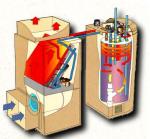Search engine visitors - click here to access entire "$ensible Home" web site
Click here to see a descriptive illustration of several designs of combination water/space heating systems.
Dear Jim: My furnace is inefficient and the water heater is old too. I might install a new combination hot water/space heating unit to replace both. Are they efficient and will there be enough hot water? - Jon S.

A: The answers are yes and yes. A combination system that produces hot air and hot water can be very energy efficient. Since the unit must have enough heat output capacity to heat your entire house, it can provide more hot water for morning showers than even the largest family could ever use.
Another advantage of a combination system is it can be used for warm floor radiant heating in one or more rooms. This is one of the most comfortable heating methods, especially in the morning when you wake up.
Instead of having two completely separate heating units, one for air and one for water, it makes intuitive sense to install a single unit that will do both tasks. A combination system requires only one contractor, fewer regular maintenance calls, produces less noise and often lower utility bills.
The space heating portion is probably no more efficient than any other super-efficient gas or oil furnace. The big savings is for the hot water because the same efficient burners are used to heat the water too. This requires a smaller built-in hot water tank for less standby losses.
There are two basic types of combination systems: integral and modular. An integral unit heats both the hot water and room air in one cabinet which is slightly larger than the typical gas furnace. A modular unit has a water heating unit that is connected by pipes to a separate air handler (blower).
In both systems, very hot water flows through a heat exchanger in the air handler. The blower circulates the room air through the heat exchanger where it picks up heat from the hot water. A central air-conditioning coil and air cleaner can be installed just like in any furnace or heat pump.
There are many types of air handler units made to fit almost any location and heating needs. Smaller ones can be mounted inside a wall to heat only one room. Other whole-house models use efficient smart variable-speed motors for comfort. They use 75 percent less electricity than standard motors.
A high-output (gas, oil or propane) water heater is needed for a large house or an inefficient smaller house. For an efficient house or one in a mild climate, an efficient, standard-output water heater often provides adequate heating capacity. Your contractor can size it properly for you.
If you are considering switching from expensive electric heat, consider a condensing system. It vents outdoors horizontally through a small plastic pipe without requiring a chimney.
Instant Download Update Bulletin No. 934 - buyer's guide of 16 manufacturers of combination integrated and modular water/air heating systems, new air handler units (single-room to whole-house sizes), super-efficient standard and high-output condensing design gas, oil and propane water heaters, heating and cooling capacities, features, size estimating chart and many illustrations of various models.
Dear Jim: I plan to install glass block windows in my utility room for security. I have heard pros and cons about whether to use a silicone or mortar installation system. Which would be best to use? - Penny T.
A: Either glass block installation method will be more secure than your existing windows. For do-it-yourself installation, the clear silicone method is easier to use and the clear joints are less apparent.
If you are having them installed, using mortar for the joints provides more security. For south- or west-facing windows, mortar joints are more efficient. The mortar acts like tiny louvers to block the summer sun's direct rays.